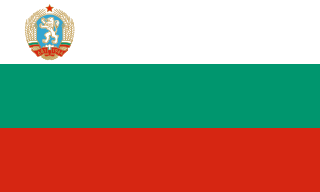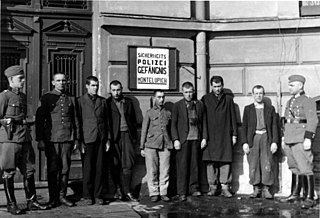Related Research Articles

The Gulag was the government agency in charge of the Soviet network of forced labour camps which were set up by order of Vladimir Lenin, reaching its peak during Joseph Stalin's rule from the 1930s to the early 1950s. English-language speakers also use the word gulag in reference to each of the forced-labor camps that existed in the Soviet Union, including the camps that existed in the post-Lenin era. The full official name of the agency changed several times.

A labor camp or work camp is a detention facility where inmates are forced to engage in penal labor as a form of punishment. Labor camps have many common aspects with slavery and with prisons. Conditions at labor camps vary widely depending on the operators. Convention no. 105 of the United Nations International Labour Organization (ILO), adopted internationally on 27 June 1957, abolished camps of forced labor.

Kimon Georgiev Stoyanov was a Bulgarian general who was the Prime Minister of the Kingdom of Bulgaria from 1934 to 1935 and again from 1944 to 1946.

Fort Breendonk is a former military installation at Breendonk, near Mechelen, in Belgium which served as a Nazi prison camp (Auffanglager) during the German occupation of Belgium during World War II.

The People's Republic of Bulgaria, from 1990 onwards known as Republic of Bulgaria, was the official name of Bulgaria when it was a socialist republic from 1946 to 1990, ruled by the Bulgarian Communist Party (BCP) together with its coalition partner, the Bulgarian Agrarian People's Union. Bulgaria was closely allied and one of the most loyal satellite states of the Soviet Union during the Cold War, sometimes being called the 16th Soviet Republic rather than an independent country. Bulgaria was also part of Comecon as well as a member of the Warsaw Pact. The Bulgarian resistance movement during World War II deposed the Kingdom of Bulgaria administration in the Bulgarian coup d'état of 1944 which ended the country's alliance with the Axis powers and led to the People's Republic in 1946.

Penal labour is a term for various kinds of forced labour which prisoners are required to perform, typically manual labour. The work may be light or hard, depending on the context. Forms of sentence involving penal labour have included involuntary servitude, penal servitude, and imprisonment with hard labour. The term may refer to several related scenarios: labour as a form of punishment, the prison system used as a means to secure labour, and labour as providing occupation for convicts. These scenarios can be applied to those imprisoned for political, religious, war, or other reasons as well as to criminal convicts.

The Soviet deportations from Bessarabia and Northern Bukovina took place between late 1940 and 1951 and were part of Joseph Stalin's policy of political repression of the potential opposition to the Soviet power. The deported were typically moved to so-called "special settlements" (спецпоселения).
The Jaworzno concentration camp was a concentration camp in WW2 German-occupied Poland and later in Communist Poland. It was first established by the Nazis in 1943 during the Second World War and was later used from 1945 to 1956 by the Soviet NKVD and then by the Ministry of Public Security and other agencies of the Polish communist regime. Today the site is an apartment complex and also houses a memorial to the camp's victims.

The Banjica concentration camp was a Nazi German concentration camp in the Territory of the Military Commander in Serbia, the military administration of the Third Reich established after the Invasion and occupation of Yugoslavia during World War II. In response to escalating resistance, the German army instituted severe repressive measures – mass executions of civilian hostages and the establishment of concentration camps. Located in the Banjica neighborhood of Dedinje—a suburb of Belgrade—it was originally used by the Germans as a center for holding hostages. The camp was later used to hold anti-fascist Serbs, Jews, Roma, captured Partisans, Chetniks and other opponents of Nazi Germany. By 1942, most executions occurred at the firing ranges at Jajinci, Marinkova Bara and the Jewish cemetery.

The history of the Jews in Bulgaria goes back almost 2,000 years. Jews have had a continuous presence in historic Bulgarian lands since before the 2nd century CE, and have often played an important part in the history of Bulgaria.

The history of Bulgaria during World War II encompasses an initial period of neutrality until 1 March 1941, a period of alliance with the Axis Powers until 8 September 1944, and a period of alignment with the Allies in the final year of the war. Bulgarian military forces occupied with German consent parts of the Kingdoms of Greece and Yugoslavia which Bulgarian irredentism claimed on the basis of the 1878 Treaty of San Stefano. Bulgaria resisted Axis pressure to join the war against the Soviet Union, which began on 22 June 1941, but did declare war on Britain and the United States on 13 December 1941. The Red Army entered Bulgaria on 8 September 1944; Bulgaria declared war on Germany the next day.

The Montelupich Prison, so called from the street in which it is located, the ulica Montelupich, is a historic prison in Kraków from early 20th century, which was used by the Gestapo in World War II. It is universally recognized as "one of the most terrible Nazi prisons in [occupied] Poland". The Gestapo took over the facility from the German Sicherheitspolizei at the end of March 1941. One of the Nazi officials responsible for overseeing the Montelupich Prison was Ludwig Hahn.

Numerous internment camps and concentration camps were located in France before, during and after World War II. Beside the camps created during World War I to intern German, Austrian and Ottoman civilian prisoners, the Third Republic (1871–1940) opened various internment camps for the Spanish refugees fleeing the Spanish Civil War (1936–1939). Following the prohibition of the French Communist Party (PCF) by the government of Édouard Daladier, they were used to detain communist political prisoners. The Third Republic also interned German anti-Nazis.

The Remembrance Day for the Victims of Political Repression is an annual day when victims of political repression in the Soviet Union are remembered and mourned across the Russian Federation.

The use of slave and forced labour in Nazi Germany and throughout German-occupied Europe during World War II took place on an unprecedented scale. It was a vital part of the German economic exploitation of conquered territories. It also contributed to the mass extermination of populations in occupied Europe. The Germans abducted approximately 12 million people from almost twenty European countries; about two thirds came from Central Europe and Eastern Europe. Many workers died as a result of their living conditions – extreme mistreatment, severe malnutrition and abuse were the main causes of death. Many more became civilian casualties from enemy (Allied) bombing and shelling of their workplaces throughout the war. At its peak the forced labourers constituted 20% of the German work force. Counting deaths and turnover, about 15 million men and women were forced labourers at one point during the war.

The forced labour of Hungarians in the Soviet Union in the aftermath of World War II was not researched until the fall of Communism and the dissolution of the Soviet Union. While exact numbers are not known, it is estimated that up to 600,000 Hungarians were deported, including an estimated 200,000 civilians. An estimated 200,000 perished. Hungarian forced labour was part of a larger system of foreign forced labour in the Soviet Union.

The Haidari concentration camp was a concentration camp operated by the German Schutzstaffel at the Athens suburb of Haidari during the Axis occupation of Greece in World War II. Operating from September 1943 until it was shut down in September 1944, it was the largest and most notorious concentration camp in wartime Greece, becoming known as the "Bastille of Greece".

The Belene labour camp, also referred to as Belene concentration camp, was part of the network of forced labour camps in Communist Bulgaria. It was located on the Belene Island, between two branches of the Danube river. At the height of Valko Chervenkov's repressions in 1952, the camp had 2,323 inmates - 2,248 men and 75 women.

The Holocaust in Bulgaria was the persecution of Jews between 1941 and 1944 in the Kingdom of Bulgaria and their deportation and annihilation in the Bulgarian-occupied regions of Yugoslavia and Greece during World War II, arranged by the Nazi Germany-allied government of Tsar Boris III and prime minister Bogdan Filov. The persecution began in 1941 with the passing of anti-Jewish legislation and culminated in March 1943 with the detention and deportation of almost all – 11,343 – of the Jews living in Bulgarian-occupied regions of Northern Greece, Yugoslav Macedonia and Pirot. These were deported by the Bulgarian authorities to Vienna and ultimately sent to extermination camps in Nazi-occupied Poland.
Anarchism in Bulgaria first appeared in the 1860s, within the national movement seeking independence from the Ottoman Empire, strongly influenced by the Russian revolutionary movement. Anarchism established itself as a distinct political movement at the end of the 19th century. It developed further in the 20th century, so much so that Bulgaria was one of the few countries in Eastern Europe where the organized anarchist movement enjoyed a real establishment throughout the country, until the seizure of power by the Bulgarian Communist Party. Under the People's Republic of Bulgaria, the anarchist movement survived underground, but was the victim of severe repression. From 1989, anarchism has been freely reconstituted.
References
- 1 2 3 4 5 6 Todorov, p.40
- ↑ Todorov, p.38-9
- 1 2 3 Todorov, p.39
- 1 2 Todorov, p.41
- ↑ Barahona de Brito, Alexandra (2001). Carmen González Enríquez; Paloma Aguilar (eds.). The Politics of Memory and Democratization: Transitional Justice in Democratizing Societies . Oxford: Oxford University Press. p. 233.
- ↑ Todorov, p.41-2